Inbound Marketing Strategy: A Comprehensive Guide
Are you looking for fresh ways to attract and engage potential customers? Well, search no more! You've just created the perfect resource: “Inbound Marketing Strategy: A Comprehensive Guide for Businesses.”
In this article, we'll unravel the magic behind inbound marketing, explore its benefits, and provide a roadmap to skyrocket your brand's online presence.
But first, let's lay the groundwork. What is inbound marketing, anyway? In a nutshell, it's a customer-centric approach that focuses on creating valuable content and experiences tailored to your target audience. Instead of pushing your message out to the masses, inbound marketing pulls prospects in by addressing their needs and providing solutions. It's all about building trust and nurturing relationships, so your brand is their go-to choice when purchasing.
Ready to dive in? This comprehensive guide will walk you through everything you need to know, from understanding your audience and crafting compelling content to mastering SEO and utilising social media effectively. So buckle up because we're about to embark on an exciting journey to transform your business and help you make a lasting impact in the digital world!
Definition of Inbound Marketing:
Inbound marketing is a methodology that focuses on attracting customers by creating valuable, relevant, and engaging content tailored to their needs and interests. This approach enables businesses to build lasting relationships with their audience and turn them loyal customers.
Table of Contents
The Importance of Inbound Marketing
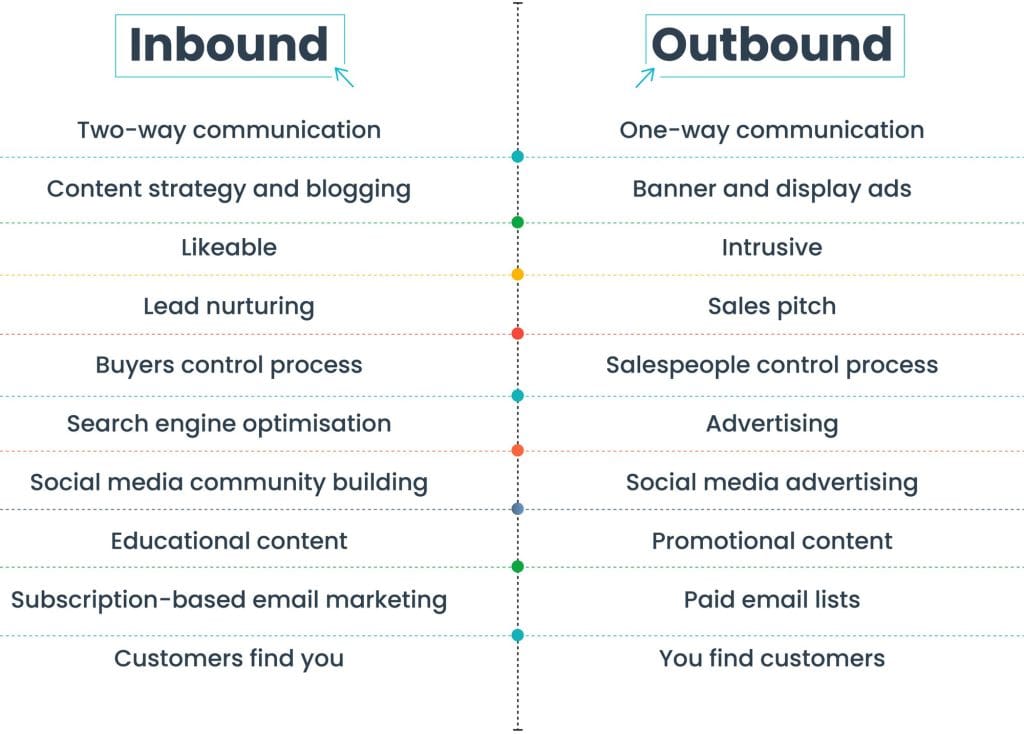
It's a strategy focusing on creating valuable content that draws people towards your brand. Instead of interrupting potential customers with ads, inbound marketing aims to attract them to your website or social media channels with content that resonates with their interests and needs.
By providing helpful and informative content, you can build trust with your audience and establish yourself as an authority in your industry. This approach also allows you to connect with potential customers more meaningfully rather than bombarding them with ads they may not be interested in.
Inbound marketing includes tactics such as blogging, social media marketing, email marketing, and search engine optimisation (SEO). By combining these strategies, you can create a comprehensive marketing plan that attracts new customers and keeps them engaged and returning for more.
If you want to cut through the noise and connect with your target audience more authentically, consider incorporating inbound marketing into your overall strategy.
The Shift from Traditional to Inbound Marketing

Do you remember those old-school marketing tactics, where ads would pop up out of nowhere and interrupt your favourite TV show? Well, those days are long gone! With the rise of digital media, consumers have more power than ever, and traditional marketing methods are becoming less effective. That's why inbound marketing has become a game-changer in the industry.
Inbound marketing is a customer-centric approach that prioritises the consumer's needs. Rather than bombarding them with intrusive ads, it focuses on creating valuable content that addresses their interests and concerns. This means providing helpful resources, such as blog posts, ebooks, videos, and other engaging content that resonates with your audience.
Inbound marketing is not just about increasing sales and generating leads; it's about creating a positive customer experience. By prioritising their needs, you show them that you care about their problems and are willing to help them find solutions. This, in turn, leads to more loyal customers who are more likely to refer your business to others.
So, consider adopting an inbound marketing approach to create a more engaging and effective way to grow your business. It's a customer-centric strategy that puts the power back in the hands of the consumer, creating a win-win situation for both your business and your customers.
The Inbound Marketing Methodology
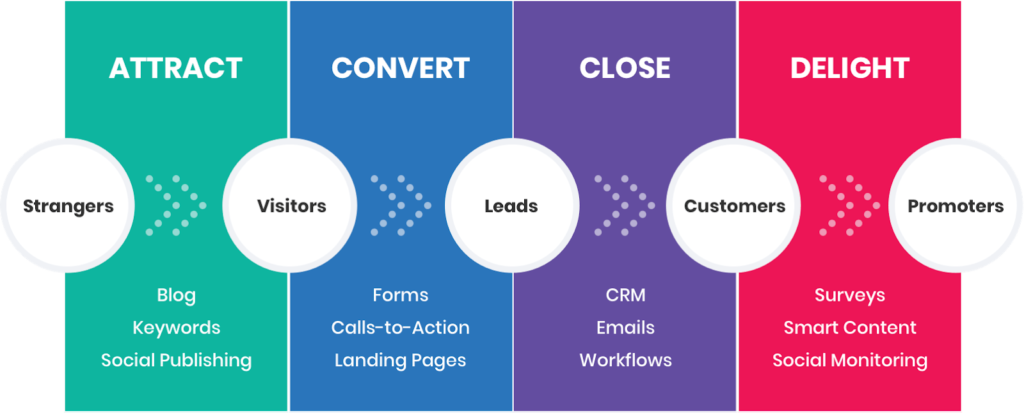
The inbound marketing methodology consists of four stages: Attract, Convert, Close, and Delight. Let's explore each step in more detail.
1 – Attract
The “attract” stage is a vital part of inbound marketing, and it's all about getting potential customers interested in what you have to offer. By providing valuable content and optimising it for search engines, you can attract more visitors to your site and start building relationships with your audience. Here are three key strategies to help you achieve this goal:
Content Creation
When it comes to inbound marketing, your content is your bread and butter. Creating high-quality, relevant, and engaging content is the foundation of the entire strategy. Whether blog posts, eBooks, whitepapers, videos, podcasts, or any other type of content, the goal is to provide valuable information that your target audience will find helpful and exciting.
By creating this kind of content, you can establish yourself as a thought leader in your industry. When people see that you share valuable insights and expertise, they'll see you as an authority in your field. This can be a powerful way to build trust and credibility with potential customers.
Of course, it's not just about creating content for the sake of it. You need to ensure your content is relevant and targeted to your audience. This means researching to understand their needs, pain points, and interests. Once you know what they're looking for, you can create content that speaks directly to them.
Ultimately, creating valuable content aims to attract potential customers to your website and build relationships with them. When people see that you're sharing helpful and relevant information, they'll likely trust you and want to learn more about what you offer.
SEO
SEO is about ensuring your content is easily discoverable by search engines like Google. When people search for keywords related to your industry or business, you want to ensure that your content appears at the top of the search results.
So how do you do this? Well, there are a few critical components to a successful SEO strategy. The first is keyword research. This involves figuring out what keywords and phrases your target audience uses when searching for information related to your business. Once you have this information, you can optimise your content and ensure it's showing up in search results for those keywords.
Next up is on-page optimisation. This involves ensuring your content is structured in a way that's easy for search engines to understand. This includes using proper heading tags, naturally incorporating keywords into your content, and optimising your images and other media for search.
Finally, building high-quality backlinks is another essential part of an effective SEO strategy. This means getting other websites to link to your content, which signals to search engines that your content is valuable and authoritative.
These elements help your content rank higher in search results and become more discoverable to your target audience. By focusing on SEO, you can increase the visibility of your content and attract more visitors to your website.
Social Media

Social media platforms like Facebook, Twitter, LinkedIn, and Instagram are:
- Excellent channels for sharing your content.
- Engaging with your audience.
- Driving traffic to your website.
But the key to success is understanding how to tailor your content and strategy to each platform and audience.
For example, Facebook is a great place to share longer-form content like blog posts and articles. You can also use Facebook to share images, videos, and other media that can help your content stand out in users' feeds.
Twitter, on the other hand, is all about brevity. With a strict character limit, you'll need to get creative with sharing your content on this platform. You can use Twitter to share bite-sized information, quotes, and links to your longer-form content.
LinkedIn is an excellent platform for sharing industry insights, thought leadership content, and updates on your company's products and services. You can also use LinkedIn to connect with other professionals in your industry and build your network.
And then there's Instagram, which is all about visual content. This platform is ideal for sharing images and videos that showcase your products, services, and brand visually appealingly.
Of course, these are just a few examples – there are many other social media platforms, each with unique strengths and weaknesses. The key is understanding your target audience and determining which platforms they're most active on.
Once you've identified the right platforms, you can develop a content strategy tailored to each. This might include creating custom graphics and videos, using hashtags to increase visibility, and engaging with your followers through comments and direct messages.
2 – Convert
So, you've done the hard work of attracting visitors to your website through inbound marketing. The next step is to start turning those visitors into leads.
So what exactly do we mean by “leads”? Well, a lead is someone who has shown interest in your business by taking some action on your website. This could be filling out a contact form, downloading an eBook or whitepaper, signing up for a newsletter, or other activities. Here are three techniques to help with this process:
Calls-to-Action (CTAs)
A CTA is a prompt that encourages visitors to take a specific action on your website. This could be anything from downloading an eBook or whitepaper to signing up for a newsletter, requesting a demo, or even making a purchase.
The key to a successful CTA is to make it clear and compelling. Your visitors should know exactly what they're getting when they click on the CTA, and they should be motivated to take action by the language and design of the CTA.
For example, if you're offering a free eBook, your CTA might say something like “Download Now” or “Get Your Free Copy”. This clarifies what the visitor will receive when they click the button.
But it's not just about the language – the design of your CTA is also essential. You want your CTA to stand out on the page, so use contrasting colours, bold text, and other design elements to make it pop. You can also use visual cues like arrows or icons to draw the visitor's eye to the CTA.
When it comes to language, use persuasive words and phrases that create a sense of urgency or excitement. For example, instead of saying “Submit”, you might say “Claim Your Spot Now” or “Join the Community”.
Ultimately, the goal of your CTA is to motivate visitors to take action and become leads. By creating clear and compelling CTAs that stand out on your pages, you can increase the chances that visitors will engage with your content and take the next step towards becoming a customer.
Landing Pages
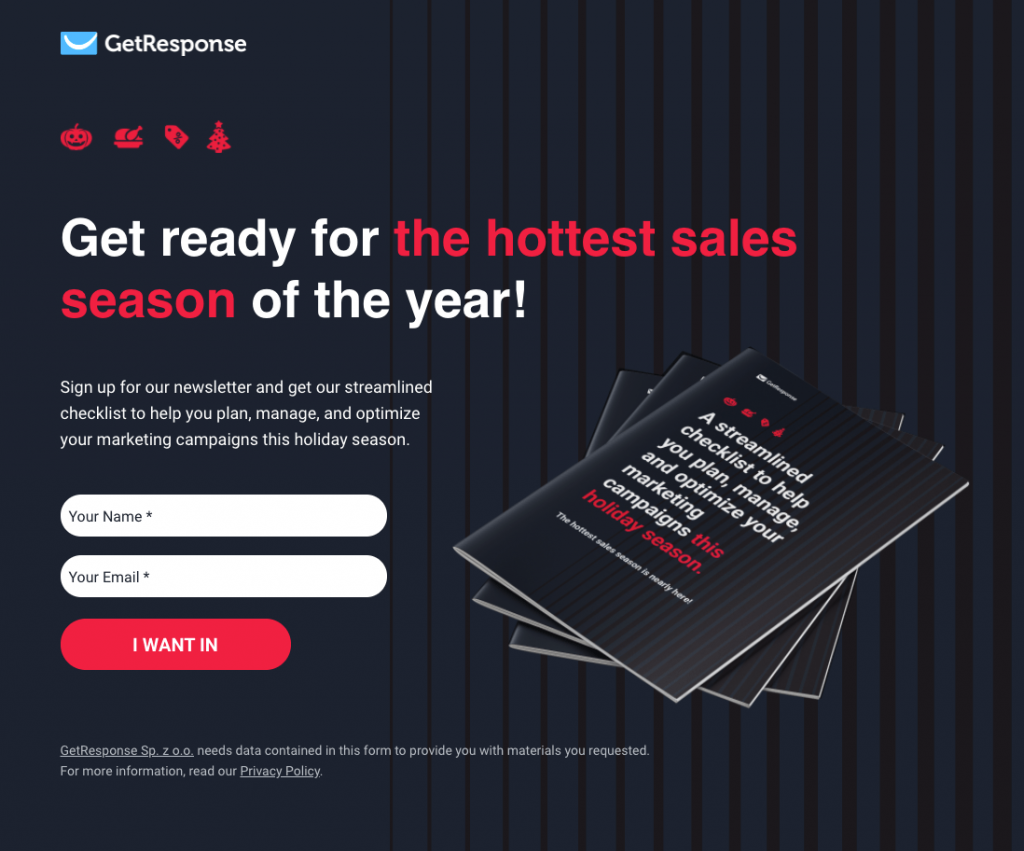
A landing page is a standalone web page that captures a visitor's contact information in exchange for a valuable offer. This could be a free guide, eBook, webinar, or any other incentive relevant to your audience.
The key to a successful landing page is to make it easy to navigate and visually appealing. You want your visitors to know precisely what they're getting when they arrive on the page, and you want to clarify what they need to do to claim your offer.
Start by using a clear and concise headline that conveys the benefits of your offer. This should be the first thing visitors see on the page. You can also use subheadings, bullet points, and other visual elements to highlight your offer's key benefits.
When it comes to design, please keep it simple and visually attractive. Use contrasting colours and bold text to make your headlines and calls to action stand out. You can also use images or videos to showcase your offer visually.
But it's not just about the visuals – you also want to ensure your landing page is easy to navigate. Keep the page focused on a single offer and avoid cluttering it with too much information. Use a clear and concise form that only requires the essential information you need to follow up with your leads.
And, of course, make sure that your offer is truly valuable and relevant to your audience. The more compelling your offer, the more likely visitors are to provide their contact information in exchange for it.
Forms
A form is a tool to collect a visitor's information, such as their name, email address, or phone number. This information is crucial for turning visitors into leads and eventually into customers.
Regarding forms, the key is to keep them concise and only ask for the information you need. You don't want to overwhelm visitors with a long list of questions, which can be discouraging and lead to lower conversion rates.
So how do you strike the right balance? Start by identifying the essential information you need to follow up with your leads. This might include their name, email address, and phone number. But beyond that, you should only ask for vital information.
For example, if you're offering a free eBook, you might only ask for the visitor's name and email address. If submitting a product demo, you might ask for more information, such as their job title or company size.
The goal is to keep the form short and sweet while collecting the information you need to follow up with your leads. You can also use smart form technology that pre-fills information you already have about the visitor, such as their name or email address, to make it even easier for them to fill out the form.
3 – Close
So you've attracted visitors to your website and turned them into leads, and now it's time to close the deal and turn them into customers!
The process of turning leads into customers is often referred to as the “sales funnel.” The funnel represents a lead's journey from initial interest in your business to becoming a paying customer. Here are three ways to do this:
Lead Scoring
Lead scoring is assigning a value to each lead based on their level of engagement and likelihood of becoming a customer. Essentially, it's a way to prioritise your sales efforts and focus on the leads most likely to convert.
So how does lead scoring work? It starts with defining the criteria to assign a score to each lead. This might include factors like:
- The lead's level of engagement with your website and content
- Their job title or company size
- The industry they work in
- Their geographic location
- Any other relevant factors that might indicate their likelihood of becoming a customer
Once you've defined your criteria, you can start assigning scores to each lead based on their level of engagement with your business. For example, a lead who has downloaded multiple eBooks, attended a webinar and requested a demo might have a higher score than a lead who has only visited your website once.
By assigning scores to your leads, you can prioritise your sales efforts and focus on the leads most likely to convert. This may involve reaching out to high-scoring leads with personalised email campaigns, offering them exclusive incentives or discounts, or providing other targeted support to move them closer to becoming customers.
Marketing Automation

Imagine this: You've got a bunch of leads in your system, and you want to move them through the sales funnel. With marketing automation, you can set up automated email campaigns that send personalised content to your leads based on where they are in the funnel. This means you don't have to spend hours crafting individual emails for each lead – automation takes care of it for you!
And that's not all. Marketing automation can also help you segment your leads based on criteria like demographics or behaviour. This allows you to target your messaging even more effectively, increasing the chances of conversion. By automating these tasks, you free up more time to focus on strategy and creative work, where your real value as a marketer lies.
In summary, marketing automation is a powerful tool that can help you streamline the sales process and deliver more personalised content to your leads. It's worth considering if you want to increase your chances of converting leads into customers!
Email Marketing
If you're looking for an effective way to keep your leads engaged and informed, email marketing could be just what you need. With the right strategy, it can be an excellent tool for nurturing leads throughout their buyer's journey.
So, how does it work? The key is to create targeted email campaigns that deliver relevant content to your audience based on where they are in the journey. This means taking the time to understand your audience's needs and pain points and tailoring your messaging accordingly.
For example, if you have a lead who's just starting on their journey and is still in the awareness stage, you might send them emails that provide educational content and helpful resources to help them learn more about your product or service. On the other hand, if you have a lead who's further along in the journey and is considering making a purchase, you might send them emails highlighting the benefits of your product or service and offer testimonials from happy customers.
The great thing about email marketing is that it lets you stay top-of-mind with your leads without being pushy or salesy. By delivering valuable content tailored to their needs, you build trust and establish yourself as a helpful resource.
Of course, it's important to remember that email marketing is just one piece of the puzzle regarding lead nurturing. It works best when it's part of a broader strategy that includes other tactics like social media, content marketing, and paid advertising.
4 – Delight
So, you've put in all the hard work of attracting leads and converting them into customers – congratulations! But the journey isn't over yet. The final stage of inbound marketing is all about delighting your customers and turning them into brand promoters.
So, what does this mean? Essentially, it's about going above and beyond to create a great customer experience. This can involve providing exceptional customer service, offering exclusive perks or discounts, and sending personalised communications that make them feel valued. Here are three strategies to achieve this:
Surveys
Surveys allow you to ask your customers targeted questions about their experience with your products or services. You can ask them about things like what they like and don't like, what problems they've encountered, and what suggestions they have for improvement.
By collecting this information, you can gain valuable insights into what works well and what needs improvement. You can then use this information to make changes and improve your products, services, and overall customer experience.
The great thing about surveys is that they're flexible and customisable. You can create surveys tailored to your business needs and send them out via various channels, such as email, social media, or your website.
Social Media Monitoring

Social media is where many people express their opinions, share their experiences, and ask questions about products and services. By monitoring these conversations and responding promptly and helpfully, you can show your audience that you're listening and care about their needs.
One of the keys to successful social media monitoring is being proactive. This means not just waiting for customers to come to you with questions or concerns but actively seeking out conversations relevant to your business and engaging with them.
When responding to customers on social media, it's important to be timely, professional, and empathetic. Even if you can't solve their problem immediately, acknowledging their concerns and letting them know you're working on a solution can go a long way towards building trust and goodwill.
By being responsive and helpful on social media, you can also create opportunities to turn dissatisfied customers into happy ones. When you can resolve a customer's issue in a public forum like social media, it can show other potential customers that you're willing to go above and beyond to make things right.
Smart Content
Simply put, smart content is personalised content that adapts to the preferences and behaviours of your audience. This means delivering tailored experiences to meet individual customers' unique needs and interests.
One way to create smart content is by using data to understand customer behaviours and preferences. For example, if you have an e-commerce website, you might use past purchases and browsing history data to suggest products likely to interest a particular customer.
Another approach to smart content is to use dynamic content that changes based on the customer's location, device, or other contextual factors. For example, you might show different messaging or images to customers based on whether they're accessing your website from a desktop computer or a mobile device.
By delivering innovative content, you can enhance the customer experience and make customers more likely to return to your business. By offering personalised recommendations and experiences, you can create a sense of connection and loyalty with your audience.
Building an Inbound Marketing Strategy
To create an effective inbound marketing strategy, follow these steps:
1 – Set SMART Goals
Let's break down what each of these means. Firstly, your goals should be specific. This means that you need to define what you want to achieve clearly. For example, instead of saying, “Increase website traffic,” you could say, “Increase website traffic by 20% in the next three months.”
Next up is measurable. You need to be able to track your progress and measure whether you're achieving your goals or not. So make sure you have a way of monitoring your progress towards your goal.
Your goals also need to be achievable. Setting unrealistic goals will only lead to disappointment and frustration. Make sure your goals are challenging but still realistic.
Relevance is also significant. Your goals should align with your business objectives and be relevant to your target audience.
Finally, your goals need to be time-bound. Setting a deadline will help you stay focused and motivated to achieve your goal.
By setting SMART goals, you'll have a clear direction for your inbound marketing efforts, and you'll be able to measure the success of your strategy. So think about what you want to achieve and how to make your goals SMART.
2 – Develop Buyer Personas
So what exactly are buyer personas? They're detailed profiles of your ideal customers. These profiles include demographics, behaviours, motivations, and pain points. By gathering this information, you can better understand your target audience and what drives them to make purchasing decisions.
Creating buyer personas is crucial in creating an effective content marketing strategy. Once you know your target audience, you can tailor your content and messaging to resonate with them. You can create relevant and valuable content for them by addressing their pain points and motivations.
For example, let's say you're a company that sells eco-friendly products. Your buyer persona might be environmentally conscious, values sustainable living, and is willing to pay more for products that align with their values. By understanding these characteristics, you can create content that speaks directly to their values and motivates them to purchase your products.
3 – Map the Buyer's Journey
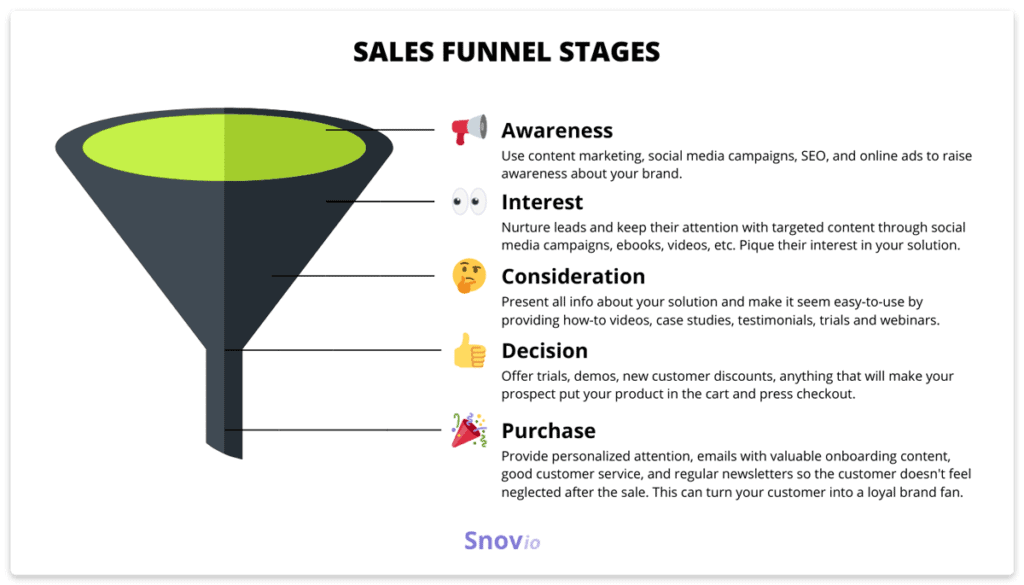
The buyer's journey typically consists of three stages: awareness, consideration, and decision. In the awareness stage, customers are just starting to recognise a problem or need they have. They may be conducting research or browsing for solutions to their problem. In the consideration stage, they actively seek information and compare different options. Finally, they are ready to purchase in the decision stage and need the final push.
You must create specific content and tactics tailored to each stage to guide leads through each step of the buyer's journey. For example, in the awareness stage, you might create blog posts or social media content highlighting the problem or need that your product or service addresses. In the consideration stage, you might make more in-depth content, such as whitepapers or case studies, that compare different solutions and demonstrate the benefits of your product or service. In the decision stage, you might use tactics such as email marketing or retargeted ads to push leads towards making a purchase.
4 – Plan Your Content Strategy
A content strategy is a plan that outlines the types of content you'll create, how you'll promote it, and how often you'll publish it. Having a clear strategy in place ensures that your content effectively and efficiently reaches your target audience.
So, how do you create a successful content strategy? Firstly, you need to identify the types of content that will resonate with your target audience. This means understanding their pain points, interests, and motivations and creating content that addresses them. You can gather this information through surveys, social media listening, and website analytics.
Once you know what type of content your audience wants, it's time to create an editorial calendar. This schedule outlines when you'll publish each piece of content and how to promote it. An editorial calendar ensures you post content consistently, vital for building trust with your audience and keeping them engaged.
Your editorial calendar should include a mix of content types, such as blog posts, videos, infographics, and social media posts. Mixing up the format and length of your content is essential to keep things exciting and engaging for your audience.
5 – Align Your Sales and Marketing Teams
Collaboration between your sales and marketing teams is essential because they are involved in the customer journey. Marketing is responsible for generating leads and creating brand awareness, while sales are responsible for converting those leads into customers. By working together, they can make a seamless experience for the customer and ensure they receive the right messaging at the right time.
To encourage collaboration, you should create opportunities for your sales and marketing teams to collaborate on projects and campaigns. This can include brainstorming sessions, joint strategy meetings, and cross-functional training programs. They can share their expertise and knowledge by bringing your teams together to create more effective marketing and sales strategies.
Measuring the Success of Your Inbound Marketing Strategy
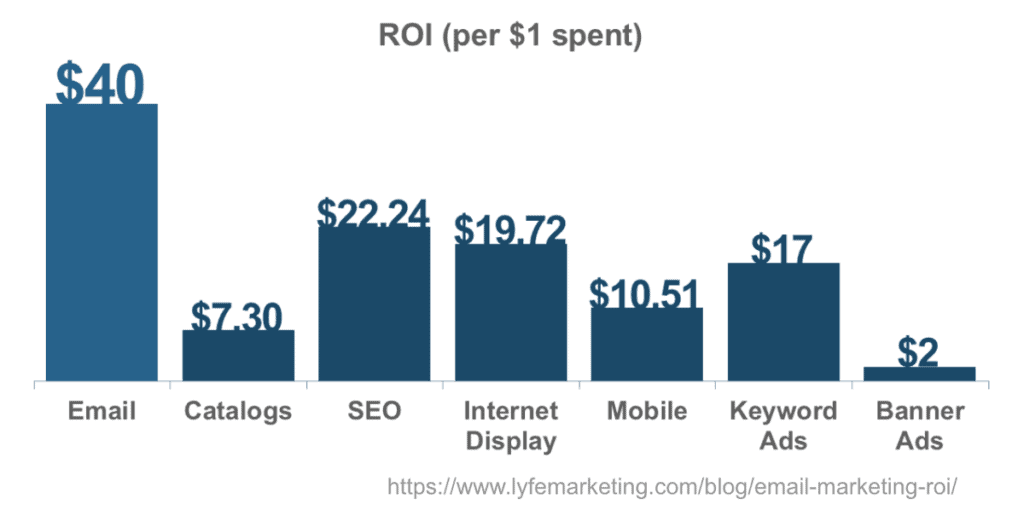
To evaluate the effectiveness of your inbound marketing strategy, consider these key metrics:
Key Performance Indicators (KPIs)
Key Performance Indicators (KPIs) are important metrics that allow you to evaluate the effectiveness of your inbound marketing strategy. They help you to determine if you are on track to meet your business goals and, if not, what areas of your system need improvement. You can identify trends and patterns that inform future decision-making by tracking KPIs.
ROI of Inbound Marketing
Return on Investment (ROI) is a critical metric to measure the effectiveness of your inbound marketing strategy. ROI compares the revenue generated by your approach to the costs incurred, giving you an understanding of the overall value of your efforts. Calculating your ROI allows you to make data-driven decisions about future marketing investments and allocate resources more effectively.
To calculate your inbound marketing ROI, you must identify your strategy's costs, including creating content, advertising, and hiring staff. It would help if you also track the revenue generated from your process, including sales from new or repeat customers. Once you have these figures, you can use the following formula to calculate your ROI:
ROI = (Revenue generated – Cost of marketing) / Cost of marketing
For example, if your inbound marketing strategy generates $50,000 in revenue and costs $20,000 to implement, your ROI would be calculated as follows:
ROI = ($50,000 – $20,000) / $20,000 = 1.5
This means that for every dollar you spent on inbound marketing, you generated $1.50 in revenue. A positive ROI indicates that your strategy generates more revenue than it costs, while a negative ROI means it is not generating enough income to cover its costs.
Continuous Improvement
Inbound marketing is a dynamic process requiring ongoing review and refinement to maintain effectiveness. To ensure that your strategy stays relevant and practical, it's essential to regularly analyse your performance data, gather customer feedback, and stay up-to-date with industry trends.
One way to analyse your performance data is by tracking Key Performance Indicators (KPIs), such as website traffic, conversion rates, lead generation, and customer acquisition. Reviewing your KPIs regularly, you can identify areas where your strategy succeeds, and improvements can be made. You can use this information to adjust your marketing tactics and improve your overall results.
Another way to refine your inbound marketing strategy is by gathering customer feedback. This feedback can be obtained through surveys, social media, or direct communication. By listening to your customers' needs and concerns, you can identify opportunities to improve your products or services, increasing customer satisfaction and loyalty.
Finally, staying up-to-date with industry trends is critical to ensuring the relevance of your inbound marketing strategy. The digital landscape continually evolves, and new technologies and channels emerge regularly. Staying informed about these changes can help you adapt your strategy and take advantage of new opportunities to engage with your audience.
Inbound Marketing Tools and Resources
Numerous tools and resources are available to help you streamline and optimise your inbound marketing efforts. Here are some popular options:
1 – CRM Systems
Customer relationship management (CRM) systems help you manage and analyse customer interactions and data. This enables you to understand your audience better, personalise your communications, and improve customer relationships.
2 – Marketing Automation Platforms
Marketing automation platforms simplify and automate various aspects of your inbound marketing strategy, such as email marketing, lead nurturing, and social media management. This can save time and increase the efficiency of your marketing efforts.
3 – Content Creation Tools
Content creation tools like graphic design software, video editing tools, and blog post editors can help you produce high-quality, engaging content for your inbound marketing campaigns.
4 – Analytics Tools
Analytics tools, like Google Analytics, help you monitor and analyse the performance of your inbound marketing efforts. Use this data to make informed decisions and optimise your strategy for better results.
Conclusion
In conclusion, mastering the art of inbound marketing is paramount in today's digital landscape. An effective inbound marketing strategy helps businesses attract the right audience and fosters lasting relationships, leading to consistent growth and increased ROI. By leveraging the power of content creation, search engine optimisation, social media, and email marketing, businesses can craft a magnetic presence that draws in prospects and converts them into loyal customers.
The beauty of inbound marketing lies in its ability to be agile and adaptive. As consumer preferences and market dynamics evolve, businesses can continually refine their strategies to remain at the forefront of their industry. Companies can reap the benefits of a genuinely comprehensive inbound marketing strategy by delivering value, fostering genuine connections, and remaining dedicated to continuous improvement.
In an increasingly competitive marketplace, those who embrace inbound marketing and make it a cornerstone of their business model will rise above the noise and achieve lasting success. The future of marketing is inbound; it's time to seize the opportunity and begin your journey towards creating meaningful, long-lasting relationships with your audience.
Frequently Asked Questions
What is the difference between inbound and outbound marketing?
Inbound marketing focuses on attracting customers by creating valuable and engaging content tailored to their needs and interests. In contrast, outbound marketing involves traditional advertising and cold calling to push messages to potential customers.
How long does it take to see results from an inbound marketing strategy?
The time it takes to see results from an inbound marketing strategy can vary, depending on factors such as your industry, target audience, and the quality of your content. However, it's essential to remember that inbound marketing is a long-term approach, and it may take several months to see significant results.
What are the critical components of a successful inbound marketing campaign?
A successful inbound marketing campaign includes high-quality content creation, SEO, social media engagement, conversion optimisation, lead nurturing, and ongoing analysis and refinement of your strategy.
How do I know if my inbound marketing strategy is working?
Monitor your KPIs, such as website traffic, conversion rates, lead generation, and customer acquisition, to evaluate the success of your inbound marketing strategy. Consider qualitative factors such as customer feedback, social media engagement, and overall brand sentiment.
What are some common mistakes to avoid in inbound marketing?
Common mistakes to avoid in inbound marketing include:
Failing to set clear goals and objectives
Neglecting your target audience's needs and preferences
Producing low-quality, irrelevant content
Ignoring SEO best practices
Failing to optimise your website for conversions
Not aligning your sales and marketing teams
Neglecting to measure and analyse your performance data
By avoiding these pitfalls and focusing on a customer-centric approach, you can increase the effectiveness of your inbound marketing strategy and achieve tremendous success in growing your business.
